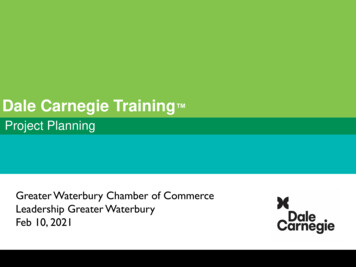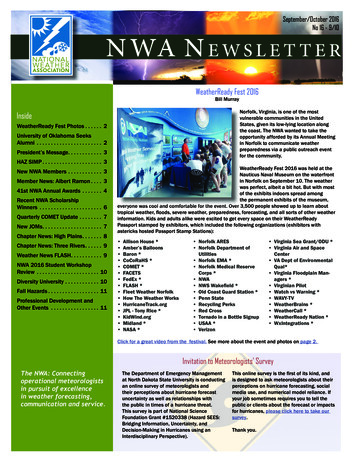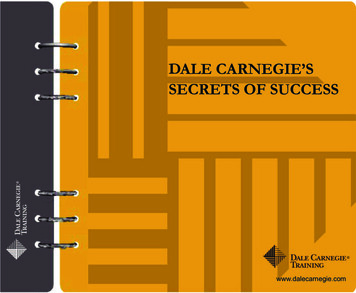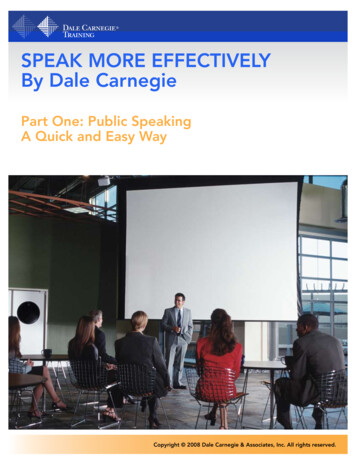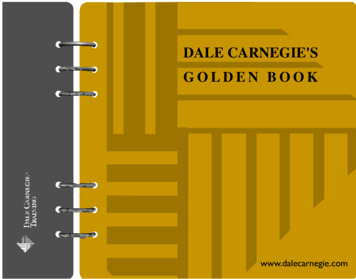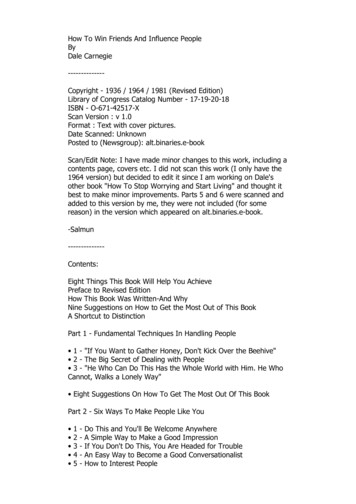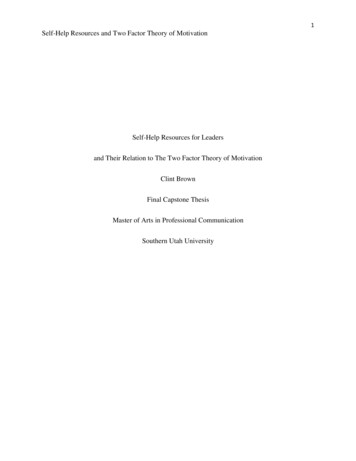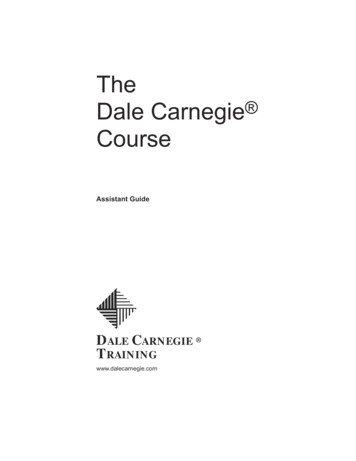
Transcription
TheDale Carnegie CourseAssistant GuideDALE CARNEGIE TRAININGwww.dalecarnegie.com
Dale Carnegie Assistant GuideTable of ContentsContact Information . . . . . . . . . . . . . . . . . . . . iiiMessage to Assistants . . . . . . . . . . . . . . . . . ivGeneral Information . . . . . . . . . . . . . . . . . . . . vHow to Get the Maximum Benefit From Being aGraduate Assistant . . . . . . . . . . . . . . . . . . . . xiGraduate Assistant Standards. . . . . . . . . . . xiiPresenting Awards. . . . . . . . . . . . . . . . . . . . xiiiInstructions for Team Leader Reports . . . . xivPlanning a Presentation . . . . . . . . . . . . . . . . xvThe Basic Structure of a Presentation . . . xviiIntroducing and Thanking a Speaker . . . . . xxContact List . . . . . . . . . . . . . . . . . . . . . . . . xxiiiMy Team’s Visions . . . . . . . . . . . . . . . . . . . xxvAwards . . . . . . . . . . . . . . . . . . . . . . . . . . . xxviiSession 1 . . . . . . . . . . . . . . . . . . . . . . . . . . . . . 1A. Foundation for SuccessArrange room—Theater styleWelcome and interact1A Lead-in—IntroductionsB. Create a VisionArrange room—Theater style1B Lead-in—Introduction and Vision2B Preview—Develop CourageSession 2 . . . . . . . . . . . . . . . . . . . . . . . . . . . . . 7A. Remember Names (Memory Pegs)Arrange room—Horseshoe styleExample—Name AssociationsMemory Demonstration—All GAsB. Vision Report (Develop Courage)Arrange room—Horseshoe style2B Lead-in—Introduction and Vision3B Preview—Defining MomentSession 3 . . . . . . . . . . . . . . . . . . . . . . . . . . . . 13A. Commit to Strengthen RelationshipsArrange room—Small groups (3 tables)Example(s)—Relationships Plan (4A)Lead small groups—All GAs3A Lead-in—Relationship CommitmentTable of ContentsB. Increase Self-Confidence (Defining Moment)Arrange room—Theater style3B Lead-in—Defining Moment4B Preview—Recognize AchievementBreakthrough AwardOutstanding Performance AwardSession 4 . . . . . . . . . . . . . . . . . . . . . . . . . . . . 19A. Set Breakthrough Goals – Commit toStrengthen Relationships ð 7AArrange room—Theater style4A Lead-in—Breakthrough Goals5A Preview—Enthusiasm CommitmentB. Recognize Achievements (Using exhibit)Arrange room—Theater style4B Lead-in—Achievement5B Preview—Persuasion ReportBreakthrough AwardOutstanding Performance AwardSession 5 . . . . . . . . . . . . . . . . . . . . . . . . . . . . 25A. Commit to Enthusiasm ð 8BArrange room—Theater style5A Lead-in—Enthusiasm Commitment6A Preview—Make Ideas ClearB. Be More PersuasiveArrange room—Theater style5B Lead-in—Persuasion Report6B Preview—Crash Through (all GAs)Breakthrough AwardOutstanding Performance AwardSession 6 . . . . . . . . . . . . . . . . . . . . . . . . . . . . 31A. Demonstrate (with props) (Make Our IdeasClear)Arrange room—Horseshoe style6A Lead-in—Make Ideas Clear7A Preview—Strengthen RelationshipsBreakthrough AwardOutstanding Achievement AwardB. Self-Expression (Crash Through Barriers)Arrange room—Cross 96B Lead-in—Crash Through7B Preview—Cooperation Commitment3 Crashing Through AwardsSession 7 . . . . . . . . . . . . . . . . . . . . . . . . . . . . 37A. Report on Commitment to StrengthenRelationships ï 4AArrange room—Theater style7A Lead-in—Relationships Report8B Preview—Enthusiasm Report3 Human Relations Awardsi
Dale Carnegie Assistant GuideB. Commit to Gain Enthusiastic Cooperationð 9AArrange room—Small groups7B Lead-in—Cooperation CommitmentLead Small Groups8A Preview—RecognitionSession 8 . . . . . . . . . . . . . . . . . . . . . . . . . . . . 43A. Realize the Power of Recognition (Give &Receive Compliments)Arrange room—Small groups8A Lead-in—RecognitionLead small groups9A Preview—Cooperation ReportSession 12 . . . . . . . . . . . . . . . . . . . . . . . . . . . 67Graduation Report (CelebrateBreakthroughs–90 secs / Renew Vision–30secs)Arrange room—Theater styleB. Introductions (20-30 seconds)3 Vision Awards3 Achievement AwardsHighest Award for AchievementB. Report on Increasing Enthusiasm (10 timesmore enthusiastic) ï 5AArrange room—Theater style8B Lead-in—Enthusiasm ReportBreakthrough AwardOutstanding Achievement AwardSession 9 . . . . . . . . . . . . . . . . . . . . . . . . . . . . 49A. Report on Gaining Enthusiastic Cooperationï 7B ð 11AArrange room—Horseshoe style9A Lead-in—Cooperation Report11A Preview—Leadership Report3 Human Relations AwardsB. Develop Flexibility (Role Playing)Arrange room—Horseshoe style10B Lead-in—Worry Report3 Crashing Through AwardsSession 10 . . . . . . . . . . . . . . . . . . . . . . . . . . . 55A. Stating Our Opinions (Disagree agreeably)Arrange room—Small groups10A Lead-in—State Opinions11A Preview—Leadership ReportB. Victory over Worry (Overcome ExcessiveWorry and Stress)Arrange room—Theater style10B Lead-in—Worry Report11B Preview—Inspiration Report3 Victory over Worry AwardsSession 11 . . . . . . . . . . . . . . . . . . . . . . . . . . . 61A. Demonstrate Leadership (Report onbecoming an effective leader)Arrange room—Small groups11A Lead-in—Leadership ReportLead small groups12A Preview—Breakthrough / Renew VisionReportB. Inspire OthersArrange room—Theater style11B Lead-in—Inspire Others3 Human Relations Awards3 Inspiration AwardsiiTable of Contents
Dale Carnegie Assistant GuideContact InformationWal-Mart Home Office DevelopmentKristal Mooney NarxFacilitatorHome Office Management DevelopmentPhone (479) 204-0018Fax (479) 273-1991E-Mail: Kristal.Mooney@Wal-Mart.comInstructorsSeth MohornManager, NW Arkansas SW Missouri MarketsCell: (479) 957-3266Office: (479) 756-2443Home: (479) 872-7109E-Mail: seth mohorn@dalecarnegie.comRon RouthPresident, Routh WreckerCell: (501) 779-0565E-Mail: rrouth@routhwrecker.comCraig CrismonPharmaceutical Rep., PfizerCell: (479) 957-2861E-Mail: Craig.L.Crismon@pfizer.comContact Informationiii
Dale Carnegie Assistant GuideMessage to AssistantsCongratulations on being selected to serve as an assistant in the Dale Carnegie Course ! You havebeen chosen for your desire to improve yourself and your eagerness to help others. You’ll retake thetraining and help others who are taking it for the first time.Participants will look to you for assistance. We thank you for assuming this leadership role. Study thisguide and be totally committed to offer assistance.Many assistants have told us they have: Developed additional leadership abilities. Improved their ability to think on their feet and express their ideas clearly. Increased their ability to deal successfully with people. Realized joy from the experience of helping others.We hope it is an enlightening and rewarding experience for you!J. Oliver CromPresident and CEODale Carnegie & Associates, Inc.The Five Drivers of SuccessMaintain a focus throughout the course on the Five Drivers of Success. Try to demonstrate them in yoursample reports, and reinforce them in your communications with class members.1. Build Greater Self-confidence2. Strengthen People Skills3. Enhance Communication Skills4. Develop Leadership Skills5. Improve your Attitude by controlling Worry and StressivMessage to Assistants
Dale Carnegie Assistant GuideGeneral InformationPreparingThe best preparation is to relive the training experience by fulfilling all the assignments. This includes thereading assignments, report preparation, and learning and using the training principles. Your applicationof the training will increase the value of your experience, and you will find it easier to help participantsunderstand and succeed.Your timing is ahead of the participants. Retake the training one week in advance. This is necessarybecause your examples and their questions will involve future sessions.It is important to reflect upon the visions of all participants, the objectives of their companies, and howeach topic pertains to their visions. An easy way to do this is to ask yourself the following question: “Inwhat ways will the next topic help each person advance toward his or her vision?”Consider completing a Breakthrough Plan at the beginning and mid-point of the training. Revise yourvision and set new breakthroughs. Use the Planning and Commitment Sheets in this guide. These willhelp you master the principles and concepts of Dale Carnegie Training . Finally, it is crucial that thetraining operate in an atmosphere of acceptance and approval. A helpful attitude and a willingness toassist in any way possible is the expectation of participants and your instructor.The RoomPlease arrive at the time requested by the instructor. Be sure the room is set-up properly and supports aprofessional and inviting atmosphere before the arrival of the first participant.Place chairs evenly and neatly with a center aisle and side aisles. The center aisle must be wide enoughfor participants and the instructor to move freely to and from the front of the room. A minimum of twochair-widths is a good general guide. Whenever possible, have an even number of chairs on each side ofthe center aisle. Add additional seats if needed at the side of each row.Place a board or flip chart in an appropriate place at the front of the room and provide writing materials ingood working condition. Post the award chart on a side wall. Position wall charts as requested by theinstructor.The table in the back of the room must present a professional image. Keep it neat and uncluttered. Haveall supplies for the session ready.During the session, restrict communications to hand-written notes. Avoid rustling papers and conductingside-conversations. Remember, there is no such thing as an unheard whisper.Greeting ParticipantsWhen participants arrive, make them feel welcome. In the earlier sessions, lead them to seats toward thefront of the room. Starting in Session Two, ask participants how they have been applying what they haveGeneral Informationv
Dale Carnegie Assistant Guidelearned in previous sessions. Let the instructor know about the successes and any challenges theparticipants may encounter.Encourage the use of the participant’s planning sheets to help them prepare their reports. Be sure eachparticipant has a topic and incident which will fulfill the session objectives. Coach participants briefly toemphasize details which will make their reports more vivid. Be sure the person is familiar and comfortablerelaying the incident. Screening reports is very important to help the participant get the most from eachsession. In the event that a participant is reluctant to have his or her report screened, simply explain thatyou are trying to help.Example ReportsThe examples given by assistants are key elements in helping the participants plan their own reports.Examples help define, in clear terms, what is expected of each participant. Always have a recent exampleof every assignment; this will help you toward your breakthroughs. Carefully select the right incident foryou and for the session.An effective example should: develop a feeling of “I can do that!” provide a clear understanding of the content expected. show the exact length of the report. indicate the structure of the report. demonstrate how the report should be delivered.Consider building your report backward. Begin with the benefit you wish the listeners to receive, thenchoose the action which supports the benefit. Follow with the incident which illustrates the action. This willhelp you send a graphic and powerful message. Practice the report before the session and with yourinstructor so that the structure, content, delivery, and impact are exactly right.Calling SpeakersYour ability to call people’s names enthusiastically enlivens any session and inspires participants to dotheir best. Consult with your instructor and use a variety of methods. Some procedures frequently usedare:A. Volunteer Front RowIn this method, one side of the front row is empty at the beginning of the session. The instructor asksfor volunteers to fill the empty row. Once it is filled, the instructor calls one volunteer as the firstspeaker. When all speakers from that volunteer row have spoken, the row is excused and morevolunteers are requested.viGeneral Information
Dale Carnegie Assistant GuideB. Designated Front RowIn this method, an assistant calls for a group to fill one side of an empty front row. The instructor callsthe first speaker from the filled row. The speakers are called until all in that row have spoken. The rowis then excused as a group and another group is called. If this method is used, be ready with thenames of the next panel well in advance.C. Volunteer Side RowIn this method two chairs are placed on each side at the front of the room. Volunteers keep the fourchairs filled without prompting. Volunteers can come to these chairs whenever they feel they areready to speak. No calling of names by the assistant is necessary unless there are a few reluctantspeakers. In this case, the instructor may ask you to call their names. Keep a record of who hasspoken so you will know whom to call.D. Call directly from seatsE. Ready chairs at the back of the roomTaking NotesThe instructor may ask you to take notes during the session. The notes can provide you and the instructorwith a record of each person’s progress. Notes can be kept on the back page of the Breakthrough Plan orin a separate notebook. Include items such as the incident, the area of the person’s life in which it tookplace, breakthroughs, and how these breakthroughs relate to the participant’s vision and companyobjectives. The instructor’s coaching and commenting might also be indicated. Consider noting when aparticipant is a finalist or award recipient.TimingBe consistent in timing participants. Start the watch with the participant’s first word and signal at the endof the allotted time. Check with your instructor for directions on how to handle the time when he/she iscoaching the participant.Signal the time remaining verbally or by waving your hand or a book. Check with your instructor as towhich method is desired. Generally, a one-minute report should receive a ten-second signal. Fortwo-minute reports, give a twenty-second signal. Be sure each person gets the same amount of time.Leading Small GroupsIn several sessions you will be responsible for facilitating a small group. There are several key points tokeep in mind.1. The timing of the group work will be centrally controlled by a designated assistant or the instructor.General Informationvii
Dale Carnegie Assistant Guide2. Keep everyone in your group on target and operate within the timing framework. No one is toexceed the allotted time. If certain participants finish before their allotted time is up, encouragethem to add details. Ask questions that will stimulate more responses. When completing a writtenreport, those who finish early should be encouraged to review what they have written and addinformation.3. Be ready to add value if your group finishes early. Ask questions to help participants identify theclassroom value of this activity.4. For voting in a small group, have the ballots ready for distribution when the vote is to be taken.Move along briskly. If there is a tie vote in your group, assume the responsibility of breaking the tiewith your vote.5. Do the group work before the session yourself. You will usually give an example of any reports tolead off your group. You will know exactly what is expected. You can then answer questions quicklywithout jeopardizing the central timing sequence.6. Avoid the temptation to teach during small group sessions. Instead, provide brief examples or usequestions to help participants.7. Be sure that the entire group pays close attention to each person in the group. This applies to youas well. Demonstrate effective human relations throughout the group work. Listen carefully andencourage each person as appropriate.8. Have the speaking order in mind before the group work begins. There should be no question as towho will begin or who will be next. Gently coach people away from using their notes when theyspeak.AwardsThe purposes for awards in the Dale Carnegie Course are to: provide recognition for achievements. challenge participants to continue to improve. build on the natural competitiveness of individuals. give participants a measure of their improvement in the training.Take a picture of each award winner after each class.BallotingBefore the session begins, sort the ballots. For example, in the small groupsessions, count out thenumber for each group and arrange them in stacks. For full group voting, count ballots out by the numberin each row so they can be handed to the person at the end of each row. This will eliminate confusion.Consult your instructor as to when the ballots are to be distributed. Consult the participant manual forvoting criteria.viiiGeneral Information
Dale Carnegie Assistant GuideDecide at the beginning of the session who will be responsible for counting each type of ballot. Do thisquickly, accurately, and outside the meeting room. Depending on the wishes of your instructor, record onone piece of paper the finalist and as many runners-up as desired. Put the ballots in a safe place, such asa pocket or purse, for disposal. If there is a tie, the votes of the instructional team will break the tie.Presenting AwardsHave the awards in hand when the time comes. Know the names of the finalists. Be sure to rememberwhich person received the most votes. Please do not take a piece of paper with the names written on it tothe front of the room. Take the time to learn the names of award recipients and locate them in the room.Be sure to make eye contact when calling their names. Memorize the standard phrases for presenting anaward outlined on page xiii.Use Pause-Part-Punch for the introductions. Have all finalists stand and remain standing untilappreciation is given to all. After they are seated, announce the top finalist. This should he done withsuspense and excitement. Practice phrases you will use so the entire experience is exciting for the groupand for you.When the finalist’s name is announced, be sure the person comes to you at the front of the room. As therecipient approaches you, have the award in your left hand, and as you shake hands, gently turn theperson around so that he or she faces the audience. At this point, you may step to the side, leaving theperson as the center of attention.Have all of the participants sign the book awards as they enter that session. Then, the recipient’s name isentered in the appropriate space. This makes each book award unique. Be guided by your instructor andsponsor as to the exact procedures to be used.An assistant or the award recipients write the finalists’ names in the appropriate spaces. Have the awardrecipient go to the exit door to be congratulated as participants leave the room at the end of the session.Contacting Participants between SessionsPart of your responsibility as an assistant may be to telephone or write participants between sessions.The call should be made when it is convenient for the participant. Be sure the call is brief and to the point.Keep it goal-oriented and helpful. Keep in mind the purpose of the call and that you and the participantsare busy people.Plan each call carefully. Get each person’s vision clearly in mind. Check the award chart on page xxvii ofthis guide so you can acknowledge awards he or she has earned.Review the participant’s achievements and be able to relate those achievements to the participant’svisions. Review the assignment for the next session so that you can discuss it with the participant. Haveyour own examples ready. Study the next session to be able to state the benefits of attending. Stories ofhow you and others have benefitted would be useful as evidence.General Informationix
Dale Carnegie Assistant GuideAfter the SessionComplete the entire session report and sign it. Review it with your instructor. Follow your local procedurefor returning the report. All official participants must be reported each week, even if they are no longerattending.Be sure names have been added to the Award Chart and store it away in a safe place. Be sure it doesnot get damaged. It shows credit for successes.Store supplies in the designated manner. Review the supply chart for the next session and notify theinstructor if anything is missing.Take a picture of each award winner.With Your Instructor. Review the Title and Learning Objectives for the session. Discuss your personal progress. Review the Participants’ progress. Discuss the next meeting with relevance to participants. Review and make assignments.xGeneral Information
Dale Carnegie Assistant GuideHow to Get the Maximum Benefit From Being aGraduate Assistant Set aside the class night for 12 weeks. Meet class participants as they arrive. Prepare ALL of your assignments carefully. Contact each person on your team at least once a week. On e-mails, please copyKristal Mooney in the Home Office as well as your instructor and Seth (if yourinstructor is either Ron or Craig). Get to know each person on your team and what their goals are by Session 3. Follow what is going on in class so you can participate at any time if called on todo so. Keep Positive! Be Enthusiastic! Lead the Applause! Watch the timer and keep thesession moving. Take the course while helping others to get the most out of the class. Remember,do the readings and prepare every assignment one week ahead of the class.How to Get the Maximum Benefit From Being a Graduate Assistantxi
Dale Carnegie Assistant GuideGraduate Assistant StandardsYou have chosen to serve as a Graduate Assistant because of your willingness to continue to developyour skills. As a Graduate Assistant, you play a very important role in the success of the class. You willfind that class members look to you as the example of what is expected of them.In order to be the most effective and present the professional image needed, we must: Arrive at class at least 15 minutes before starting time. A half hour to 45 minutes isbetter, if you can make it that early. This gives you an opportunity to practice anysample talks you are giving, as well as to greet class members and be ofassistance to them. All Graduate Assistants should be up mingling, rather thansitting at a table. If you are assigned to open the session, please have the title and purpose of thesession (A or B) written on the board as directed by your instructor. Open thesession precisely on time with enthusiasm. Welcome the class and state the titleand purpose. If you are not doing the warm up, turn the class over to theinstructor. When you are giving a sample report, distributing something, or presentingawards, be up and ready. Don’t wait for the instructor to call on you and then try toget out from behind a table. Remain seated at the table unless you are getting ready to perform one of yourassigned functions. This minimizes the chance of distracting the class. Their focusremains on the instructor. Be prepared for all reports each week. Create an impression of being a “step above.” Demonstrate this through poise,posture and self-confidence.xiiGraduate Assistant Standards
Dale Carnegie Assistant GuidePresenting Awards(Memorize)1) “The three people receiving the most votes for tonight’s (award) are,in no particular order, and please stand when your name is called.”(Call out the names.)2) “Please be seated. (Motion with hands)”3) “And the top vote getter is (name) .”REMEMBER: Hold the award high so the whole class can see it.Announce the names in a clear, quick and forceful voice.You lead the applause.Make certain all three are seated before the top vote getter is announced.Let there be a pause before announcing the top vote getter. This will buildsuspense. Wait for the award winner to come to you, shake his/her hand and place the awardwinner at the front of the room, then back off to the side, leaving that person in theproper position to give an acceptance speech.Presenting Awardsxiii
Dale Carnegie Assistant GuideInstructions for Team Leader ReportsIt is very important to fill out this report completely It serves many purposes. The Absentee Section shouldlist the people who are absent this session, as well as:1.2.3.4.If they were contacted this sessionReason they were absentOther sessions that were missedDrops need to be shownIf there are any make-ups, it is important that they are listed in the “make-up” section. The attendancenumbers should be checked to make sure the number absent plus the number present equals the totalnumber enrolled in the class.In order to send recognition to the award recipients’ managers, we need to make sure that all awardwinners are listed and what awards they received.xivInstructions for Team Leader Reports
Dale Carnegie Assistant GuidePlanning a PresentationBegin by Addressing: Who is my audience? What is my purpose? What is my message?Who Is My Audience?It is as difficult to satisfy the unknown expectations of an audience as it is to hit an unseen target. It canbe done, but it is a chancy way to seek success. Part of the process of preparation is the research thatgathers the following information about the audience.KnowledgeThe most obvious consideration about the knowledge level of the audience thatconcerns most presenters is: “Is the audience better informed than I am?” This isprobably the less serious of the presenter’s concerns, because it will stimulateadequate preparation. The greater problem, though, is the danger of assuming theknowledge level of the audience. Never face an audience unprepared, but also neverfall into the trap of assuming listener ignorance and talking down to the audience.ExpertiseThe skill level of the audience is also important because that may determine theposition on the issue you want to take.ExperienceThis consideration is not only how much experience the audience has, but at whatlevel and in what environment. Experience in a laboratory is significantly differentfrom experience in the field.PrejudiceIf you can identify the prejudices of the audience, you can determine where they arestarting from and some of the pitfalls you will need to avoid.NeedsIn order to send the listeners home with a sense of satisfaction—and feeling gladthey were there—it is wise to address their needs. Theory is important when buildingevidence, but eventually you must “get the hay down out of the loft so the horses caneat it.”WantsSimilar to needs are the audience’s wants. Wants and needs are not always thesame, and if you only address needs, it is difficult to satisfy an audience and movethem to action.GoalsDetermine the goals of your audience and keep them in mind as you plan yourpresentation.Planning a Presentationxv
Dale Carnegie Assistant GuideWhat Is My Purpose?There are only a few purposes for a presentation. Following are the most accepted ones.ConvinceThe purpose of many presentations is simply to get the audience to do something.The challenge is to persuade the audience to make a decision or to take action.InformAnother useful purpose is to present information for the enlightenment of youraudience, perhaps to enable them to do something. This format focuses on clarityand understanding.MotivateWhen an audience needs to change their opinion or take an unpopular action, thepurpose of the presentation is to motivate. While similar to the purpose of convincing,in this case, the audience may face greater obstacles and need to be given sufficient“whys” to make them anxious to take action. The audience needs to be moved fromtheir present condition or opinion.EntertainIn one sense, every presentation should entertain. For the audience to be in afavorable frame of mind and open to being convinced, enlightened, or motivated, theyneed to be entertained. Entertainment is not necessarily based on humor, althoughthat can be a big part of it. In the broadest sense, to entertain an audience is to makethem glad they were there and glad you were the presenter.What Is My Message?It hardly seems necessary to address the importance of having a message but, unfortunately,presentations sometimes lack a message, or at least a message that is easy for the audience to takeaway. Such presentations are either scheduled to merely fill time, or there are so many messages woveninto them, that it is impossible to identify anything significant. Be sure you know what the message is andkeep it in mind throughout the preparation, so that the presentation stays on track.xviPlanning a Presentation
Dale Carnegie Assistant GuideThe Basic Structure of a PresentationOpeningFavorably attract immediate interest from the audience.MessageClearly state your message or theme.EvidenceEstablish credibility and inspire respect and confidence by using convincingevidence.ClosingLeave the audience with a favorable, memorable impressionOpening a PresentationThe opening of a presentation differs from its content. Its distinct purpose is to elicit the audience’sinterest in you and your message.ExamplesStartlingStatement“We all have the same amount of one very important asset—time.”“Last year, a million drills were sold in the United States—and not a single personwanted one.”Question Basedon Need orInterest“If there were a better way to market the Z2-29 symbol, you would be interested,wouldn’t you?”“If I could tell you a way to avoid heart attacks, you surely would want to listen,wouldn’t you?”MysteriousStatement“When you fold your arms, which one is on top—the right or the left?” (This openingwas used in a speech on habits and the difficulty of changing set habits.)“Your company’s greatest asset will never show on a balance sheet!” (This was theopening to a speech regarding the value of employees.)Compliment“Your Chairman told me about your great support in improving community spirit, and Icongratulate you.” And what this shows about you is.” (The beginning of a speechgiven to a group of co-workers in the community after a luncheon.)“Sincere congratulations to the 121 percent sales increase whic
help you master the principles and concepts of Dale Carnegie Training . Finally, it is crucial that the training operate in an atmosphere of acceptance and approval. A helpful attitude and a willingness to assist in any way possible is the expectation of participants and your instructor. The Room Please arrive at the time requested by the .



